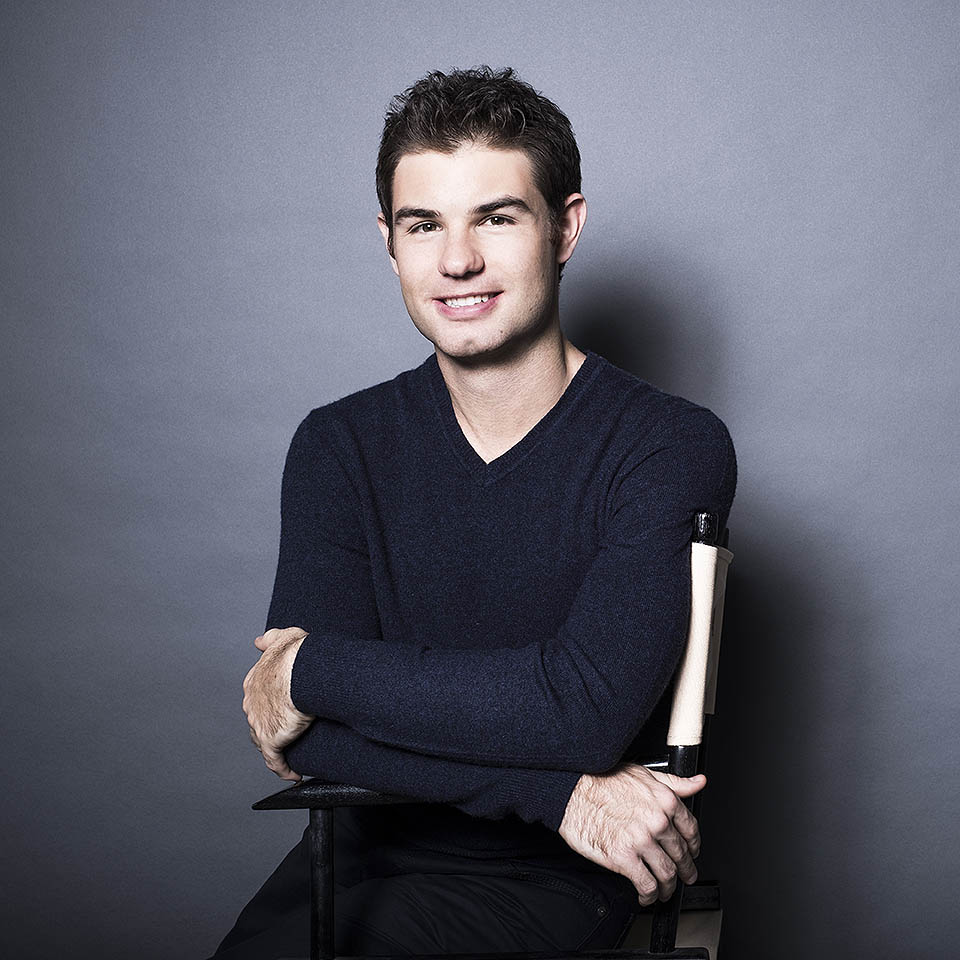
Bravo Bravado
Sunday, Nov 16, 2025 | 3:00 PM
A bold and expressive program brimming with color, power, and lyrical beauty. We begin with Flagello's Bravado, a spirited work sponsored by the New Music Society that opens the door to Ravel's sparkling Piano Concerto in G, performed by acclaimed pianist Drew Petersen. The concert culminates in Sibelius's majestic Symphony No. 2—a work of sweeping emotional arcs and triumphant Nordic grandeur, often seen as a musical declaration of independence.
Bravado is sponsored by the New Music Society. Join the New Music Society today to support the creation and performance of new music.
Pre-concert Talk
A pre-concert talk with Music Director Bruce Anthony Kiesling will begin at 2:10 PM, giving audiences insight into the program and the music they will hear.
Concert Information
Ticket Prices
Sunday, Nov 16, 2025 | 3:00 PM
Dawson Auditorium, Adrian College
Bruce Anthony Kiesling, conductor
Drew Petersen, piano
- FLAGELLO Bravado
- RAVEL Piano Concerto in G
- SIBELIUS Symphony No. 2
Guest Artist
Drew Petersen, piano
Drew Petersen is an acclaimed New York-area based American pianist celebrated for his compelling and poetic performances across a diverse repertoire, from Bach to Zaimont. Recognized as a sought-after soloist, recitalist, and chamber musician, he has earned numerous accolades, including the 2018 Avery Fisher Career Grant, the 2017 American Pianists Awards, and the Christel DeHaan Classical Fellowship.
The 25/26 season includes recitals in series from San Diego, CA to Westfield, NJ with a program ranging from Mozart to Liszt and John Adams, as well as concerto debuts with the Baltimore and Hartford Symphonies. 2018 marked the release of his first solo recording of music by Barber, Carter, and other American composers on the Steinway & Sons label for which BBC Music Magazine acknowledged his presence as a rising star.
A frequent radio contributor, Petersen has performed on platforms such as McGraw-Hill Young Artists Showcase, From the Top, and Performance Today. His performances and profiles have been featured in The New York Times, New York Magazine, and the award-winning documentary Just Normal by Kim Snyder. An enthusiastic chamber musician, he has appeared on France Musique as part of a Verbier Festival piano trio.
His inclusion in Andrew Solomon’s bestseller Far From the Tree sparked a national dialogue on raising extraordinary and different children. Dedicated to advocating for classical music and the arts, he was awarded the 2006 Davidson Fellows Award for his project, Keeping Classical Music Alive. He has also collaborated with Young Audiences NY to bring performances to New York City’s public schools.
Petersen is also a passionate traveler whose career takes him all over the world, where he explores new cuisines and connects with locals just as eagerly as he performs for fresh audiences. A Harvard graduate, he earned his Bachelor of Liberal Arts in Social Science with honors at just 19 years old. He also completed both his undergraduate and graduate music studies at the prestigious Juilliard School, where he was awarded the renowned Kovner Fellowship. Deeply committed to the role of music in today’s global society, Petersen has gained a unique perspective on how musical performances can uplift and enrich humanity. Through his extensive concert experience, he hopes to share his musical journey with others, inviting audiences to witness the transformative power of the arts firsthand.

Program Notes
Bravado
Gala Flagello (1994 - )
Gala Flagello is a composer and educator who has been building a reputation in the world of composing since being selected as a 2022 Composition Fellow at the Aspen Music Festival and 2023 Composition Fellow at Tanglewood Music Center. Prior to that she had received first place honors in a number of prestigious composition competitions beginning in 2020. She received her formal training at The Hartt School and holds a Doctor of Musical Arts degree from the University of Michigan.
Bravado was written in 2023 for the Tanglewood Music Festival. The composer tells us that it explores the many meanings of the old Italian word "bravo" meaning "wild" or "courageous". Reviewers have suggested a person with bravado can be alternately "bold or reckless, daring or arrogant, confident or overbearing," and the orchestra is meant to describe all of these traits as the primary melody is transformed.
The piece opens with the introduction of that primary melody, punctuated by bell tones. A transition section follows and introduces a new theme in the French horn. Some have suggested that this theme is reminiscent of some of Leonard Bernstein's work, particularly West Side Story. Bernstein was at Tanglewood for 50 years. The music moves forward and at the halfway point, there is a more somber section of interplay between woodwinds and brass. This secondary theme is resolved in a bold statement from trumpets and horns, and the work ends with a firm statement of the opening lilting introduction.
In addition to composing, Flagello is also committed to the education of new talent. She teaches composition privately, and encourages the creation of new music. She works with her students to develop their ideas into fully formed pieces. She is also interested in teaching them innovative ways to incorporate visual arts and technology into their works. In addition, she tries to build into her music her commitment to social issues such as environmental awareness, gender equality and mental health.
Her planned concert season for 24/25 included the European premiere of some of her work with the BBC Symphony Orchestra, including an international broadcast, as well as Bravado with the Detroit Symphony.
Beryl McHenry
Piano Concerto in G Major
Maurice Ravel (1875 – 1937)
Maurice Ravel is one of the most tragic figures in the ranks of great composers, his career cut short by a brain disease that left him helpless, unable to write or play an instrument. He was mentally intact during the final stages of his disease but had no way to compose and could barely communicate. Both speech and motor functioning were affected, and Ravel was full of ideas for musical compositions, without any way to act upon them. One is reminded of Beethoven’s deafness, and of Bach’s increasing blindness. These men, however, were able to continue to compose in spite of their disabilities. Ravel was not.
Ravel was able to complete the Piano Concerto in G Major in 1932. By that time his disease was making itself felt, and when Ravel struck his head severely in a car accident in 1932, it appeared to accelerate the progress of the disease. His illness worsened so rapidly that he was forced to retire after completing, with great difficulty, one more work, a Don Quixote song cycle.
The Piano concerto in G Major has three movements. The first, Allegramente, begins with the crack of a whip, launching the pianist into arpeggios in the high range of the piano, then into jazz themes, picked up by the composer during a recent tour of America. This movement is lively and flowing. The second movement, the Adagio assai, is characterized by gorgeous cadences and a quieter mood. The third movement, Presto, is incredibly fast and incredibly difficult, calling forth the solo pianist’s best efforts to produce the scintillating, forceful melodies, with meter and rhythm struggling for supremacy. The entire work is the Impressionist Ravel at his most brilliant.
Ravel wanted to premiere the work himself for its first performance in January of 1934, after which he had planned an extensive tour ending in Japan. He was prevented from both these desires by his advancing disease, which made playing the keyboard impossible. He actually survived six years after this first performance but never responded to treatment. In a final attempt to relieve his symptoms, surgery was performed. It was not successful, and Ravel lapsed into a coma, living only eight more days.
Beryl McHenry
Symphony No. 2 in D major
Jean Sibelius (1865 - 1957)
Jean Sibelius composed seven symphonies. When he wrote his second symphony he was already a widely respected composer in his homeland of Finland, having presented Finlandia to the world almost simultaneously with his first symphony. He had already composed a body of pieces inspired by Finnish folklore, but he wanted his symphonies to stand alone without these associations. The first symphony proved that he could do exactly that.
Following the success of his first symphony Sibelius took a break from composing. He and his wife were grieving the loss of their infant daughter to typhoid fever, Sibelius himself suffered from poor health, alcoholism and depression. There were money problems, and he was in a continuous state of anxiety about his standing in the musical community. Encouraged by a friend and admirer, he and his wife took a villa in Italy, where he began his second symphony. The restorative atmosphere is reflected in a certain sunlit quality in the opening of Symphony No.2, and it finale reflects a sense of wellbeing. He returned to Finland and completed the work at a country retreat, premiering it at Helsinki University in 1902. It was immediately accepted and performed across Europe and in the United States.
The first movement opens quietly with a set of fragments of melody, which then come together before separating themselves once more. It is a masterful shaping of the fragments and the movement ends with the same peaceful mood as the opening. The second movement, a slow sonata, begins with a pizzicato display by cellos and basses, which are joined by the bassoons and a contrasting strain in the strings. It is a long movement, with changes in mood throughout. Sibelius’s third movement, a scherzo, contains energetic strings and pastoral oboe and blends seamlessly into the final movement, the most famous. It closes the work with a huge statement of the melody, which listeners have been hearing fragments of throughout.
Sibelius completed five more symphonies, but critics were not as accepting, having now embraced the new avant-garde composers - Stravinsky, Schönberg and similar. This criticism, along with his struggles with alcoholism and depression, contributed to his retirement from composing and nothing new was written for the last 30 years before his death. This, in spite of a commission to write an eighth symphony, which he reportedly began but never finished.
American music scholar Milton Cross wrote, "The first two Sibelian symphonies do not have subtlety of expression. They wear the heart on the sleeve. But what they lack in subtlety, they make up for in dramatic effect. They have an overwhelming emotional impact."
Beryl McHenry
